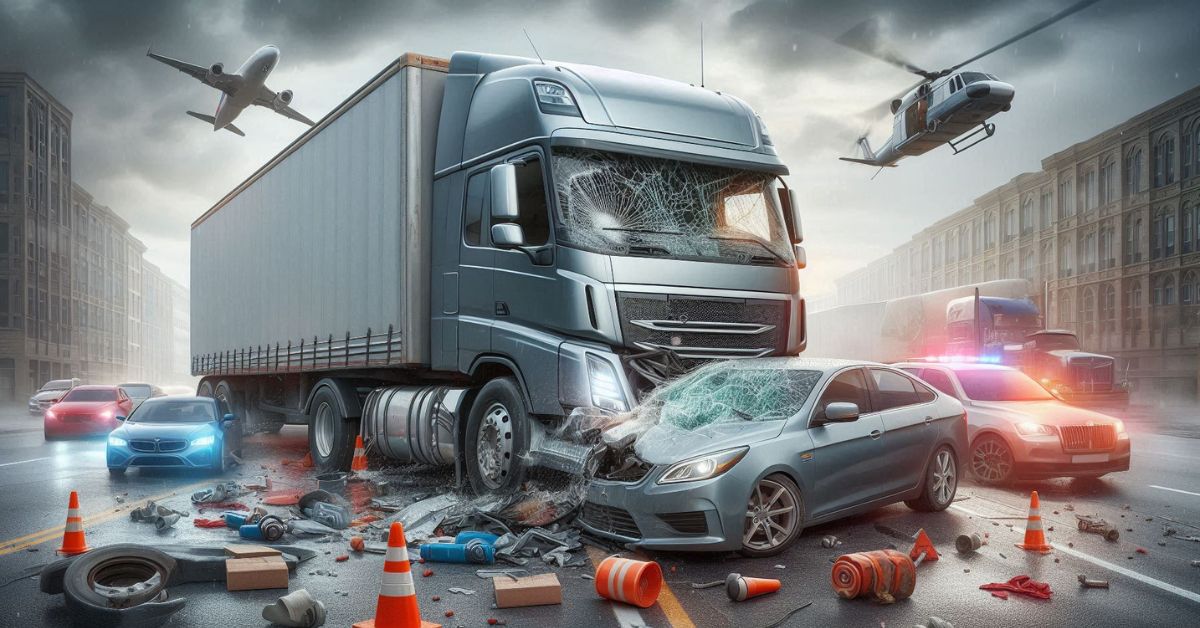Truck accidents are significantly more dangerous than typical car crashes due to several key factors, including the size and weight of trucks, the severity of injuries, and the complexity of liability. Understanding these differences can help drivers stay safer on the road and be more aware of the risks involved.
1. Size and Weight Disparity
One of the most obvious reasons truck accidents are more hazardous than car crashes is the sheer size and weight of commercial trucks. A fully loaded semi-truck can weigh up to 80,000 pounds, whereas the average passenger vehicle weighs about 3,000 to 4,000 pounds. This significant difference means that in a collision, a car absorbs most of the impact, leading to devastating consequences for the occupants of the smaller vehicle.
2. Greater Impact Force
Because of their weight and momentum, trucks require a much longer stopping distance compared to cars. A fully loaded truck traveling at 65 mph can take over 500 feet to come to a complete stop, whereas a passenger car only needs about 300 feet. This makes rear-end collisions involving trucks particularly catastrophic, as they can crush smaller vehicles entirely.
3. Increased Risk of Severe Injuries and Fatalities
Statistics show that truck accidents result in more serious injuries and fatalities compared to regular car crashes. The National Highway Traffic Safety Administration (NHTSA) reports that over 70% of fatalities in truck accidents involve occupants of smaller vehicles. Common injuries include traumatic brain injuries, spinal cord damage, internal bleeding, and multiple fractures, all of which have long-term consequences for victims.
4. Jackknifing and Rollover Risks
Trucks have a higher risk of jackknifing or rolling over due to their design and weight distribution. When a truck jackknifes, its trailer swings out at an acute angle, creating a hazardous obstacle for other vehicles. Similarly, high winds, sharp turns, or sudden maneuvers can cause a truck to tip over, potentially crushing nearby cars and causing multi-vehicle pileups.
5. Hazardous Cargo Spills
Unlike passenger cars, commercial trucks often carry hazardous materials such as gasoline, chemicals, or flammable liquids. In an accident, these substances can spill, leading to fires, explosions, or environmental contamination. A truck accident involving toxic cargo can result in widespread road closures, health risks, and additional fatalities.
6. Driver Fatigue and Operational Challenges
Truck drivers are often under pressure to meet strict delivery deadlines, leading to long hours behind the wheel. Despite regulations limiting drive time, fatigue remains a leading cause of truck accidents. A drowsy driver has slower reaction times and impaired judgment, increasing the likelihood of severe crashes. Additionally, truck drivers face challenges such as blind spots, difficult maneuverability, and adverse weather conditions, all of which elevate accident risks.
7. Complexity of Liability and Legal Consequences
Unlike typical car accidents, truck crashes involve multiple parties, including the truck driver, trucking company, vehicle manufacturer, and cargo loaders. Determining liability can be complex, and victims may face challenges when seeking compensation. Trucking companies often have powerful legal teams, making it essential for accident victims to seek legal assistance from the best truck accident lawyers to ensure fair compensation for their injuries and damages.
How to Stay Safe Around Trucks
While truck accidents are inherently more dangerous, both truck drivers and passenger vehicle drivers can take steps to reduce risks:
- Avoid Blind Spots – Trucks have large blind spots on their sides and rear. If you can’t see the truck driver in their mirrors, they can’t see you.
- Maintain a Safe Following Distance – Avoid tailgating trucks, as they have a much longer stopping distance.
- Pass With Caution – Always pass a truck on the left side where visibility is better, and never cut in front too closely.
- Be Patient – Trucks take longer to accelerate and turn, so give them ample space and time to maneuver.
- Watch for Wide Turns – Trucks make wider turns, especially at intersections. Give them room to avoid collisions.
Conclusion
Truck accidents are more dangerous than car crashes due to size disparities, severe impact forces, increased injury risks, and operational challenges. By understanding these dangers and practicing safe driving habits, motorists can reduce the risk of devastating accidents. If you or a loved one is involved in a truck accident, seeking legal and medical assistance is crucial to ensuring proper compensation and recovery.
Also Read: The Growneer Rotary Tool Kit: A Comprehensive Guide

